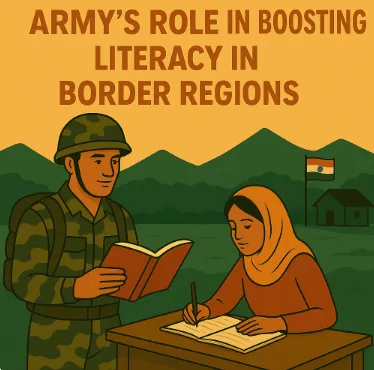Border regions are often marked by rugged terrain, isolation and limited access to basic facilities. Among these, Education is one of the most affected sectors. Poor infrastructure, shortage of teachers and difficult accessibility make literacy levels in these areas lag behind the national average. In such circumstances, the Indian Army has emerged as the protector of borders and as a promoter of literacy. Through its various outreach programs, goodwill schools and community initiatives, the Army has become a catalyst for change in the educational landscape of border communities.
Border areas in Jammu and Kashmir, the North-East or remote Himalayan villages face a common problem: inadequate schools and teachers. Civilian agencies often find operating difficult due to geographical and security challenges. With its presence in these regions, the Army has taken up the responsibility of bridging this gap. Soldiers stationed in forward areas often assist in running makeshift schools, organising evening classes, and motivating children to pursue Education despite hardships. By setting up Army Goodwill Schools in Jammu & Kashmir through Sadbhavana Projects, the Army has provided structured educational opportunities to thousands of children. These schools impart quality education and instil discipline, moral values and a sense of national pride. The trust built by the Army in these regions has encouraged parents to send their children, especially girls, to school.
One of the flagship initiatives of the Army to promote literacy is Operation Sadbhavana. Started in the 1990s in Jammu and Kashmir, the project aimed to win hearts and minds by addressing local developmental needs, with Education as the top priority. Under this project, the Army has constructed schools, provided scholarships and distributed study materials. Similarly, in the North-Eastern states, the Army organises National Integration Tours where students from border regions are taken to metro cities to expose them to different cultures, universities and career opportunities. These tours broaden the horizons of children who otherwise grow up in isolation. Such initiatives break the cycle of ignorance and underdevelopment by motivating young minds to aspire higher.
In many border areas, literacy among women is alarmingly low. Traditional barriers, coupled with a lack of facilities, often deprive girls of Education. Recognising this, the Army has made special efforts to empower women through literacy programs, vocational training and girl-specific scholarships. Many Goodwill Schools have separate facilities for girls, creating a safe and supportive environment. By encouraging girls’ Education, the Army uplifts individual families and strengthens the social fabric of border regions. Educated women become catalysts for change, ensuring that future generations embrace literacy.
Soldiers often turn into teachers in remote posts where schools are absent. During off-duty hours, they conduct classes under trees, in bunkers, or in community halls. Their involvement goes beyond textbooks – they mentor children, instil confidence and spread awareness about national unity. These acts create a bond between the Army and local populations, reducing alienation and fostering trust. For many children, soldiers are defenders of the nation and their first teachers. This unique dual role enhances the Army’s image as protector and nurturer.
The Army also plays a crucial role in building and maintaining infrastructure directly impacting Education. From constructing school buildings in inaccessible areas to providing solar lamps, stationery and digital tools, the Army ensures that the flame of learning does not die. In areas prone to natural calamities, Army units often rebuild damaged schools quickly, restoring hope among children. Moreover, the Army channels resources effectively through collaborations with NGOs and government schemes. Their credibility ensures that aid reaches the intended beneficiaries without diversion.
Education in border regions is not just about literacy but about fostering national integration. The Army ensures that these students feel a part of the national mainstream by introducing modern curricula, teaching about India’s diversity and exposing children to opportunities nationwide. Youngsters educated under Army initiatives often pursue higher studies and join professions in cities, carrying stories of the Army’s support. Many also aspire to join the Armed Forces, strengthening the bond between the Army and border communities.
Despite its commendable efforts, the Army faces several challenges in promoting literacy. Harsh weather conditions, insurgency threats and a shortage of trained teachers are persistent hurdles. Maintaining continuity in Education during frequent disruptions is another difficulty. Yet, the Army’s determination and resilience enable it to sustain these initiatives. The increasing enrolment and literacy rates in these regions are testimony to their success.
The role of the Army in boosting literacy in border regions goes far beyond conventional duties of defence. By establishing schools, mentoring children, empowering women and building infrastructure, the Army has emerged as a beacon of hope for marginalised communities. Its efforts not only spread literacy but also foster trust, integration and national pride. In regions where the sound of guns often drowns the voices of children, the Army has ensured that the pen remains mightier than the sword. Thus, Education becomes a tool of empowerment and a bridge between the Army and the people it protects.


